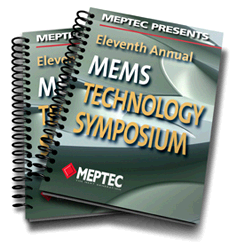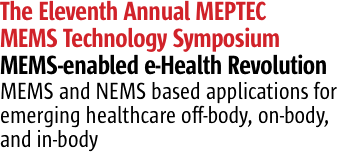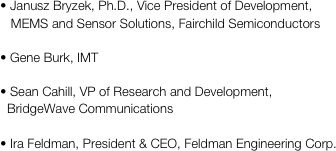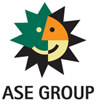 |
||||||||||||||
 |
||||||||||||||
 |
||||||||||
 |
||
 |
||
 |
||||||
 |
||
 |
|||||
 |
|||||


For inanimate objects, microelectromechanical systems (MEMS) sensing is sufficiently accurate. Measuring and providing meaningful information about people, however, is significantly more complex. This challenge may be why some technologists differentiate types of sensors based on their location: off-body, on-body (wearable), and in-body (implantable or digestible), as their packaging and functionality significantly vary.
Most successful MEMS sensors to-date for animate objects are off-body and on-body, typified by smart phone and fitness applications. Not only is obtaining meaningful data easier for these applications, they most often do not need biocompatibility testing or medical regulatory approval.
As more applications move to on-body, and in-body sensors emerge, sensor sophistication and packaging technologies need to significantly improve. Self-administered medical diagnostics are envisioned using one’s smartphone as the computing and communication engine. These systems require accuracy and repeatability to adequately detect acute symptoms while preventing false positives. eHealth solutions will demand unique and flexible packaging from sensors to system creating additional technical challenges and providing new market opportunities. While raw data is of great value, increasing software sophistication is expected with the ultimate goal of local interpretation and understanding of sensor data (“doctor on a chip”).Adequacy in the clinical medical setting is being systematically proven for more and more devices, enabling new diagnostic and therapeutic methods.
MEMS and nanoelectromechanical systems (NEMS) based products with embedded actuators are starting to emerge, creating smart drug delivery systems. In combination with sensors, these technologies promise a dramatic restructuring of the medical industry. Patients may easily obtain (at low cost) diagnostic and therapeutic equipment in the first phase of this evolution, receive diagnosis from sophisticated embedded software (doctor on chip) in the second phase, and play a significant role in dramatically reducing the root causes of medical problems through personalized medications and gene therapy in the third phase.
As a byproduct of the eHealth revolution, the skyrocketing costs of medical care are expected to come under control, and a much higher standard of healthcare brought to every person on Earth, creating healthcare Abundance1 in the next 20 years.
Invited speakers will focus on sensors, actuators, and architectures that enable the eHealth revolution. Technologies that increase the accuracy or reliability of devices, lower manufacturing costs, and/or enable unique diagnostics or treatment will be highlighted.
Mark Concept of Abundance was introduced by Peter Diamandis of XPrize Foundation in his book “Abundance”. Abundance is defined as equality between supply and demand for goods and services on Earth. www.abundancethebook.com
On the day following this event, MEPTEC and MEMS Journal are co-presenting the second annual MEMS Business Forum. The Forum will continue the theme of tremendous MEMS growth by inviting business, academic and technology experts to discuss the key issues that will help enable Can the MEMS market and drive the growth. Discounted attendance and exhibiting opportunities are available to those who wish to attend both events. Contact bcooper@meptec.org for pricing details.

The cost to exhibit is $595.00 for members and MEMS Business
Forum exhibitors, and $695.00 for non-members and includes:
• 6’ table, draped
• 2 chairs
• 11”x17” custom table top sign with your logo and company
description
• One admission to the conference
• Logo, link to your URL and company description on special
Exhibitor page
• Company description in the symposium proceedings
• Printed and electronics versions of the symposium proceedings
• Marketing exposure through e-mail campaign
Click here for pricing and to reserve a table now.
For more information contact Bette Cooper at bcooper@meptec.org
or call 650-714-1570.
Sponsoring this event will provide a valuable opportunity to promote your company brand and product/service message to attendees, while supporting your business development and positioning goals. For pricing and benefits click on the Application Form link below. For more information contact Bette Cooper at bcooper@meptec.org or call 650-714-1570.
Pricing for general admission is $485.00 for MEPTEC members and $585.00 for non-members and includes attendance, continental breakfast, refreshment breaks, lunch, and printed proceedings. A credit card is needed to hold the reservation.
Pre-registration is strongly recommended. There will be no guarantee of space or materials for on-site registrants.
Final confirmation including maps and directions will be sent before May 18th.
Refunds for advance payment, less a $50 processing fee, will be given in full provided cancellation by phone or e-mail is received 10 business days before the event (Monday, May 9). If you do not cancel by May 9 or are a no-show, the credit card provided to hold the reservation will be charged for the full amount.
A block of rooms has been reserved at the San Jose Holiday Inn (formerly the Wyndham Hotel) for a rate of $139.00. The hotel is conveniently located at 1350 North First Street, San Jose, CA in close proximity to the San Jose Airport. To reserve on line go to www.holidayinn.com and enter MEP into the Group Code box. The $139 rate will automatically come up.
You can also call 408-453-6200 to reserve your room; be sure to mention MEPTEC in order to secure the special rate.
.

As of 4-1-13 – listed alphabetically by last name
MEMS and Sensors for eHealth - Market Overview
Jérémie Bouchaud, Director and Principal Analyst MEMS
and Sensors, IHS iSuppli
MEMS are already established for medical applications. The market was worth $265 million in 2012 and grows at 7.4% CAGR to $370 million in 2016. At the borderline of consumer applications, MEMS for mobile health applications is in its infancy but starts to create substantial additional opportunities for sensors suppliers.
IHS will present the various segments for mobile health at the border between consumer and medical applications. Drivers will be presented such as the fast adoption of Bluetooth Low Energy on the technical side and the importance of social media on the societal aspect. Current market barriers will be presented as well as key players in this ecosystem. IHS will also quantify the opportunities for MEMS and other types of sensors for mobile health.
eHealth: Path to Healthcare for All
Dr. Janusz Bryzek, VP Development, MEMS and Sensing Solutions, Fairchild Semiconductor
Cost of medical care in the US exceeded 18% of GDT and is growing at unsustainable rate 8%/year. Globally, estimated 4 billion people do not have access to medical care.
While many governments try to constrain escalation of medical care with little success, an unexpected global tide labeled as eHealth (also tagged as mHealth or Digital Health) emerged. As an example, at 2013 CES Show in Las Vegas, there were 19 Digital Health conference sessions and 350 exhibitors in Digital Health section.
eHealth has been enabled by unprecedented growth of mobile market driven by smart phones fusing computing, communication and sensing and making it affordable. Mobile sensor absorption grew from 10M units in 2007, to 3.5B units in 2012, with forecasted growth to trillions by 2023.
Concept of Abundance was introduced by Peter Diamandis of XPrize Foundation in his book “Abundance” www.abundancethebook.com. Abundance is defined as equality between supply and demand for goods and services on Earth. It is estimated we could reach it in just one generation (20 years) as a result of 8 exponential technologies (sensors being one of them) enabling growth of supplies and services in excess of the global demand for them. Abundance targets elimination of global hunger, lack of water and energy, as well a lack of medical care though eHealth.
eHealth is based on low-cost diagnostic and therapeutic sensors and actuators communicating with low cost mobile devices for data processing (including diagnosis) and communication with health data bases and doctors. MEMS is one of technologies enabling low cost high volume fabrication of sensor and actuators.
First application of eHealth focused on reuse of acceleration sensor from cellphones for activity monitoring. With time, additional sensors have been deployed, and on the horizon there are large number of sensors and actuators targeting eHealth. The costs of select medical instruments have already plummeted by an order of magnitude or more, promising significant cost reduction of medical care.
An example could be an ultrasound scanner. Laboratory version sells for $100k. Doctor’s version introduced in 2012 sells for about $2500. Consumer version could be available in a year or two for about $200.
Availability of personal diagnostic and therapeutic devices with software based diagnosis will deliver much better medical care than currently available. It will be enabled by statistical processing of all information available in the world data bases, tailored for a given patient.
This presentation will overview selected existing developments and emerging eHealth applications.
E-health revolution enabled by wearable MEMS motion trackers
Job Elders, Ph.D., Senior VP Strategic Alliances, Xsens
MEMS motion trackers enable accurate 3-dimensional data of motion in general and next generation wearable MEMS motion trackers enable 3 dimensional body motion in particular. Body motion data provide a wealth of information which will be exploited in the near future to support the health and comfort of human beings.
This presentation explores the product requirements and technology challenges of wearable MEMS motion trackers for e-health applications. In addition the presentation will discuss examples of health applications based on MEMS motion trackers.
Advanced Manufacturing of Integrated Labs-on-a-Chip
for Ubiquitous Diagnostics
Gisela Lin, Ph.D., Center Development Manager, Micro/Nano Fluidics Fundamentals Focus (MF3) Center, University of California, Irvine
MEMS/NEMS developments are already changing the world in healthcare by bringing new capabilities and modalities for sensing and processing. The Micro/Nano Fluidics Fundamentals Focus (MF3) Center is an industry-academia-government consortium formed in 2006 and is headquartered at the University of California, Irvine. Our mission is to create a focused community that performs fundamental micro/nano fluidic (MF) research to develop standardized MF integration processes and device technology that promotes MF commercialization. Together with industry, this research team is working to address the critical challenges facing large scale production of labs-on-a-chip to bring low-cost, ubiquitous diagnostics to fruition and thus enabling eHealth solutions for healthcare. These devices will have sensors, microfluidic sample and reagent handling, and the ability to connect to mobile devices for data transfer. Combined with existing telecommunications infrastructure, these manufacturable, integrated labs-on-a-chip will enable distributed, fast, real-time diagnostics anywhere in the world. Results from recent MF3 developments in low-cost, scalable, lab-on-a-chip development and integration will be presented.
Wireless Health: Remaking of Medicine by Pervasive Technologies
Mehran Mehregany, Ph.D., Goodrich Professor of Engineering Innovation, Director, Wireless Health Program,
Director, Case School of Engineering San Diego Programs
Ubiquitous connectivity and computing are bringing about unprecedented mobility—allowing working, entertainment, shopping, socializing, gaming, etc., anytime, anywhere. This trend is also infiltrating health care, promising significant improvements in quality, convenience, reach and cost of care through “wireless health” solutions. Wireless health solutions enable diagnosis, therapy and monitoring of health-related conditions by tracking relevant biomarkers, managing treatment regimen and monitoring progress—while the patient goes about her daily life. At the same time, microsystems are increasingly enabling nonintrusive measurement of health and disease conditions, as well as delivery of therapy on demand. Social networks are promoting peer comparisons and competitions in health and wellness, motivating behavioral change and providing a community of support. Meanwhile, advances in genomics are ushering in the new era of personalized medicine. The convergence of these trends will result in individualized, preventative medicine that is time and place independent and are explored in this presentation.
Mouth Guards, Sweatbands, and Bandages:
On-Body Chemical Sensors
Dr. Christopher Salthouse, Dev and Linda Gupta Professor of Electrical and Computer Engineering, University of Massachusetts, Amherst
In the next ten years, mHealth sensors will grow beyond existing mechanical sensors to include electrical, optical, and chemical sensors for on-the-body sensing. Of these, chemical sensing presents both the biggest challenges and the greatest benefit. Chemical sensing can measure hundreds of parameters including pharmaceuticals, hormones, metabolities, immune response, and pathogens. Making these measurements requires novel sensor design, packaging, and system design because the sample must come in contact with the sensor. At the University of Massachusetts, Amherst we are launching a new center to catalyze both academic and industrial research on mHealth sensing systems. For on-the-body chemical sensing we are exploring mouth guards, sweatbands, and bandages.
Miniaturized electronic packaging for wearable health monitors
Jayna Sheats, Ph.D., co-founder and CTO, Terepac Corporation
Advances in MEMS process technology, coupled with the extraordinary production volume provided by mobile phones, have brought about cost reductions for a wide range of sensing functionalities which are reminiscent of the well-known Moore's Law for digital electronics, even though sensors are analog devices. These devices have great potential for continuous, unobtrusive monitoring of many physiological phenomena, which can provide valuable real-time feedback to individuals on their well-being, reduce visits to clinics for medical intervention, and lower the cost of effective healthcare. In order to realize this potential, however, they need to be comfortable to wear (to the point of being unnoticed), use very little power, and be quite inexpensive: this implies smaller, thinner electronic modules, ultimately with a band-aid-like form or labels integrated into clothing. We will describe a packaging technique which can enable this goal.
Revolutionizing Consumer Fitness & Digital Health:
Ultrathin Conformal Electronics
Ben Schlatka, co-founder and Vice President, Business Development, MC10
Abstract to follow
Printed and MEMS Gas Sensing Systems: The Next Generation of Situational Awareness in the Trillion Sensor Universe Joseph R. Stetter, Ph.D., KWJ Engineering
To understand your particular situation, you will need sensors to augment your senses and describe the important aspects of the external environment and your internal status/health. With information from sensors, predictive algorithms can then provide awareness as well as guidance for action [actuators]. The mobile communications platforms are driving packaging and sensing requirements and are poised to deliver the future promise of personal medicine at your fingertips and awareness of what is happening around you, what environment you are in, and also your personal status in the moment. We live in a sea of gas, breathe oxygen mixtures, and are sensitive to increasing concentrations of greenhouse gases and pollutants. Compatible gas sensors will be not only be useful but required for mobile heath networks. The revolution in printed electronics and MEMS is enabling a new generation of gas sensors for the mobile platform with wireless connection to/among conformal and embedded devices. Recent developments in printed and MEMS gas sensors for oxygen, carbon monoxide, methane, carbon dioxide, and ozone provide examples of the novel form factors, innovative apps, and revolutionary scalable manufacture/cost paradigms now available to gas sensors and how these are enabling the e-Health revolution.
Other speakers include:
Mark Zdeblick, Ph.D.
Co-Founder and Chief Technical Officer, Proteus Biomedical
Abstract to follow
Exponential growth of sensors in mobile applications over the last five years brought dramatic reduction of sensors footprint, cost and power consumption. These advances started to enable the next market Tornado, digital health. Initial products focused on wearable “wellness” devices driven by simple sensors, such as accelerometers, pulse, sweat and temperature sensors. In parallel, more advanced devices started to reach the market, such as ECG monitors, ultrasound imagers and body fluid analyzers. One of the notable developments in this market is emergence of “doctor-on-a-chip”: cellphone software performing medical diagnostics.
At the post-conference reception a special showcase called Digital Health for All of Us will be held to introduce selected healthcare and wellbeing products driven by sensors and sensor software. During the reception, attendees will have an opportunity to have hands on demo with such products. The session will be open to symposium attendees, outside industry groups, editors and the public.
Showcase companies to be announced












